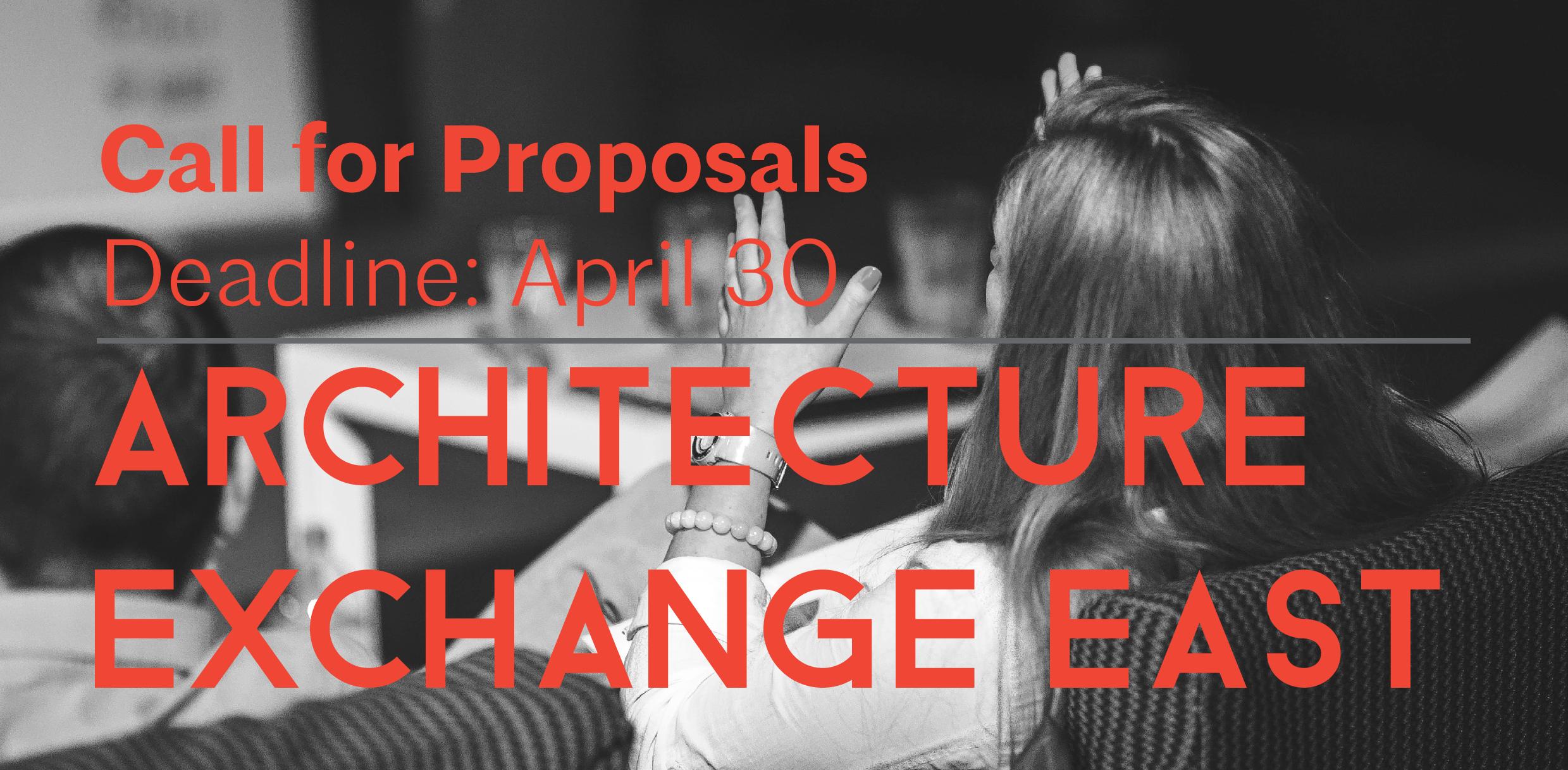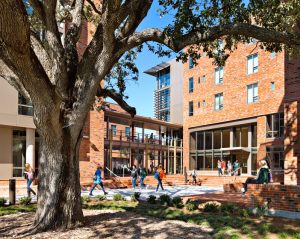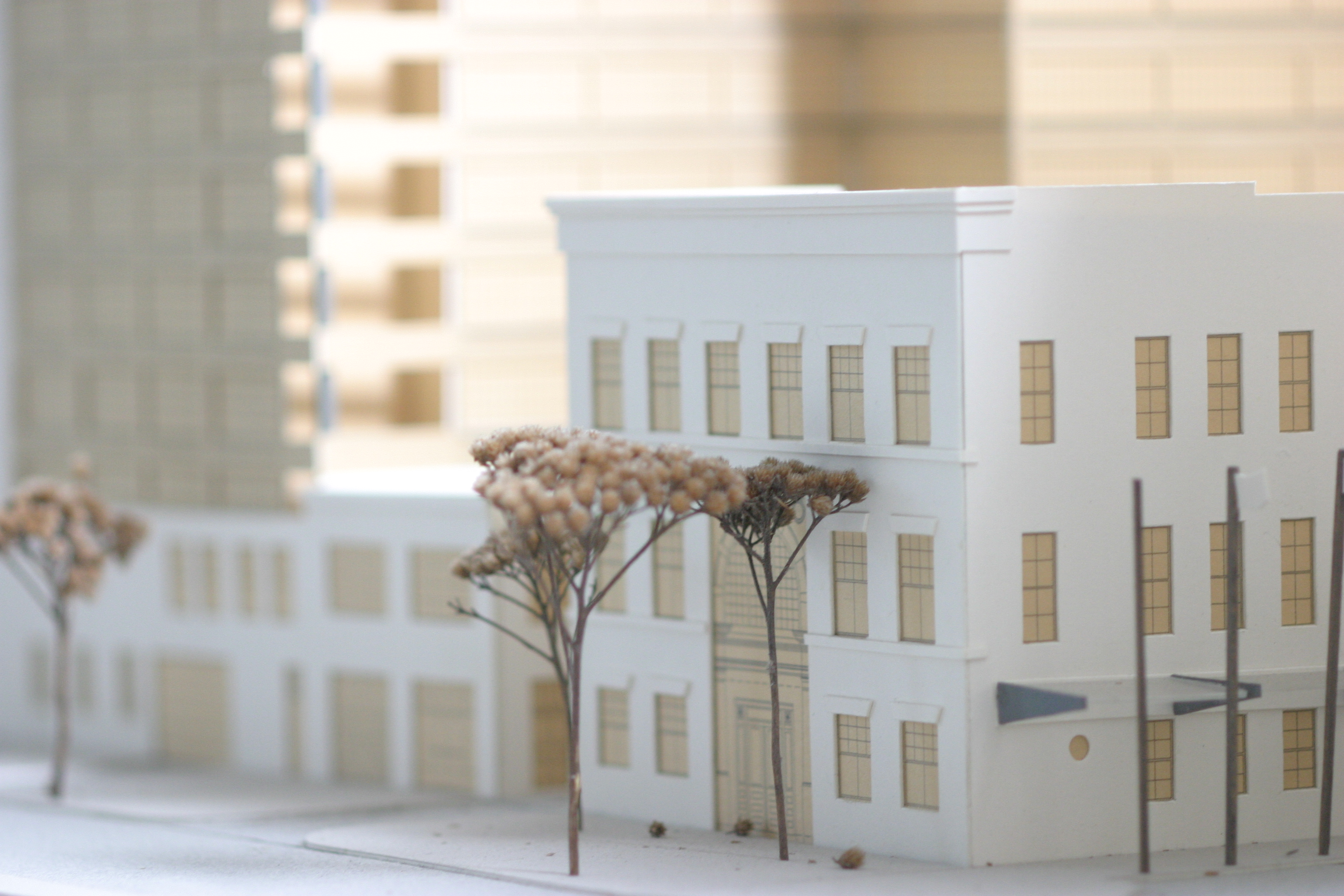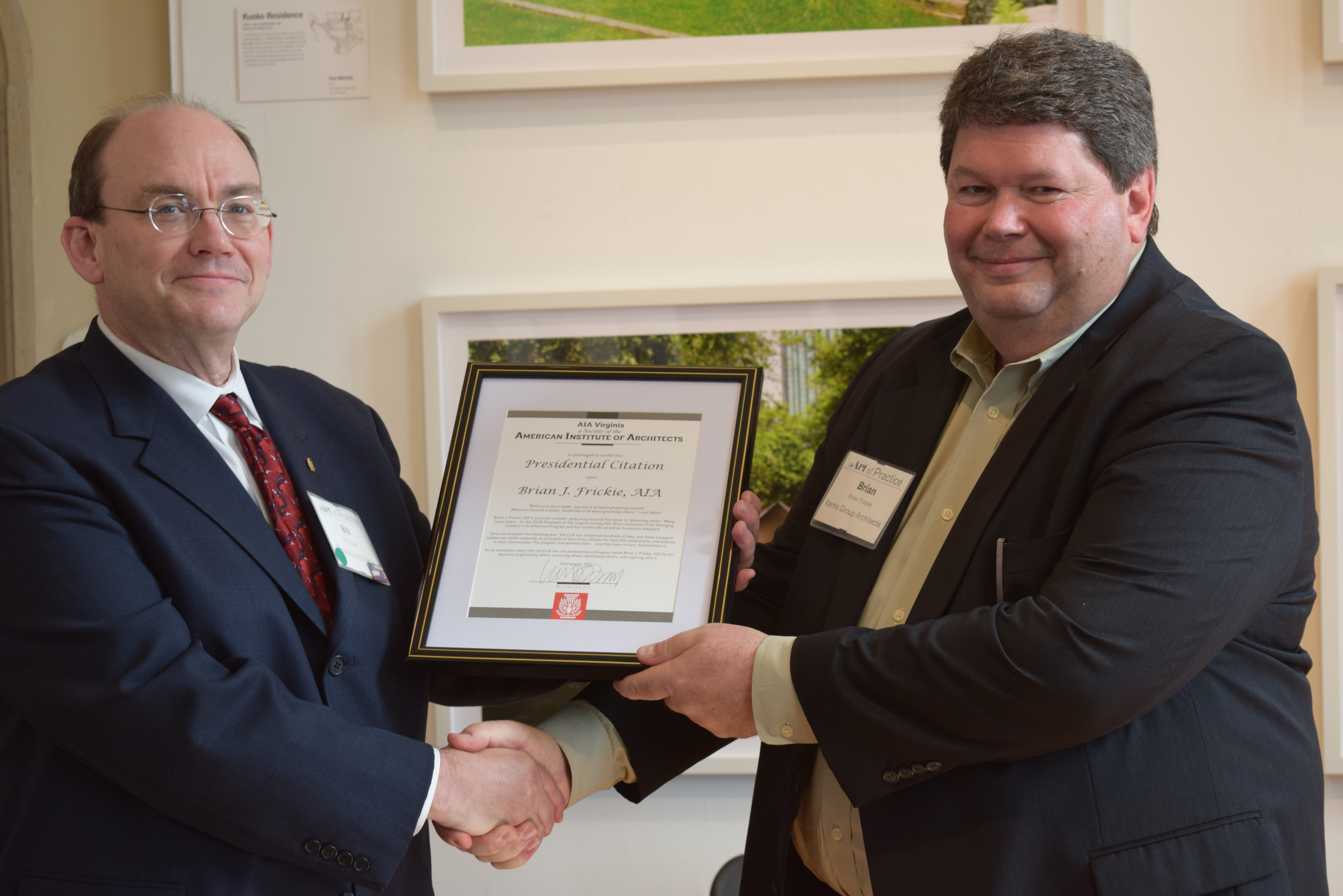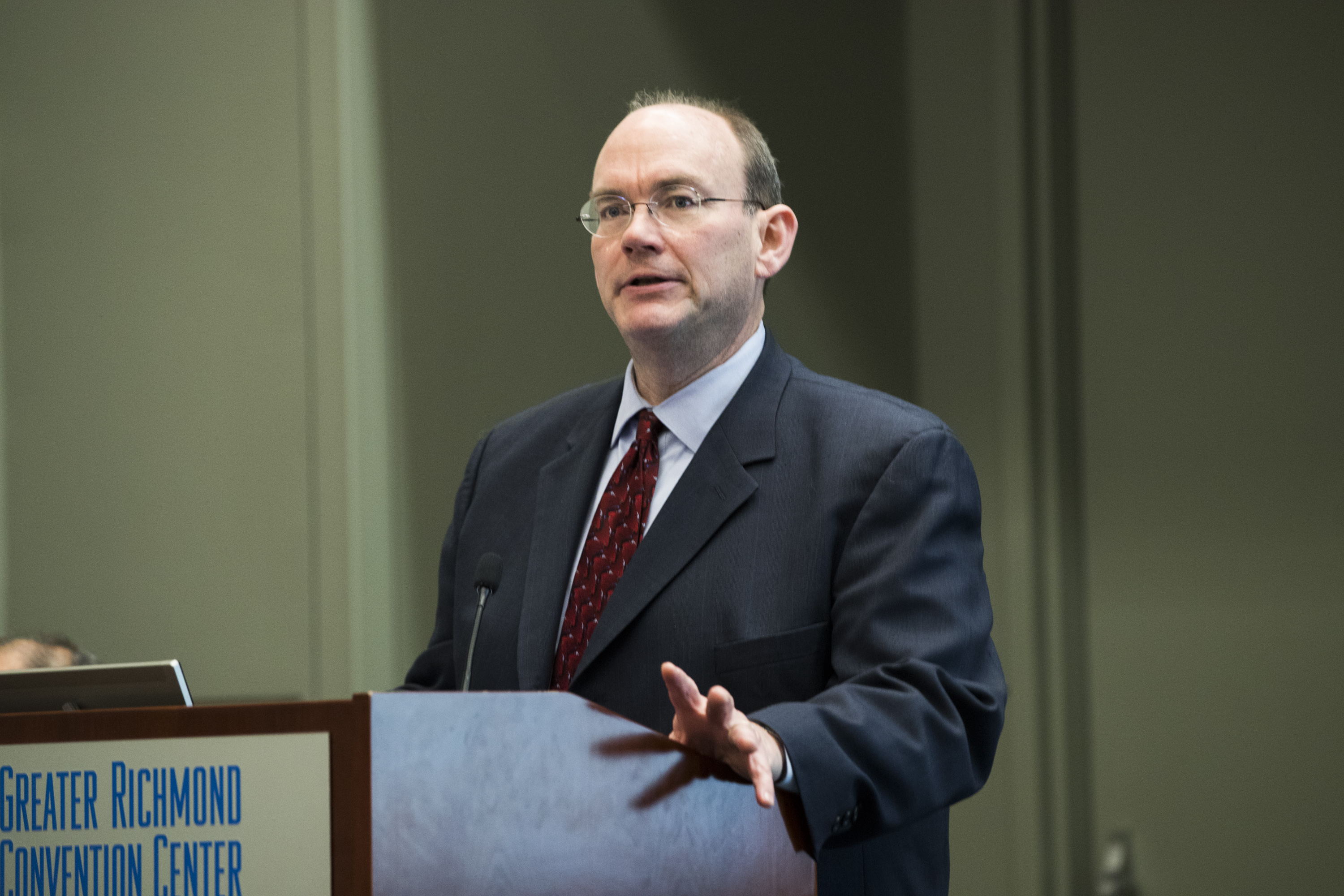The AIA Virginia Prize is a design charrette that engages students at all of the accredited schools of architecture in Virginia. Conducted simultaneously at Hampton University, University of Virginia, Virginia Tech, and the Washington-Alexandria Architecture Center, students are given the competition program Friday at 5 p.m. They work over the weekend to create a board presenting their design solution at 9 a.m. the following Monday. Each school’s faculty reviews the submissions and sends up to 10 finalists to Richmond for final judging. Learn more about the AIA Virginia Prize.
A’19
AIA Conference on Architecture
Deadline Extended for ArchEx Call for Proposals
The deadline to submit your presentation proposal for Architecture Exchange East has been extended until April 30, 2018.
This year’s conference will be held Nov. 7–9, 2018, in Richmond, Virginia, and will bring together an audience of more than 1,000 architects and allied professionals over the course of the three-day event.
Our goal is to bring together the brightest minds and most engaging speakers to present talks that are future-focused on a wide range of subjects — and to provoke important conversations between design professionals.
Your talk could range from a one-hour session to a full-day workshop. We don’t want to box you into a particular format. We’re encouraging creative approaches to content delivery, including panel discussions, tours, and guided collaborative conversations.
To propose a seminar, workshop, or tour, complete the Presentation Proposal Form by April 30, 2018. Your proposal will be reviewed and you will be contacted by July 2018.
What Did the Trees Do Wrong?
As part of the work in our strategic plan, AIA Virginia will be including interesting and relevant articles written by our members and guest authors. We would like to thank Rob Reis, AIA, from Hanbury for submitting this article. If you would like to submit an article for the member newsletter, contact Cathy Guske at cguske@aiava.org
What Did the Trees Do Wrong?
submitted by Robert V. Reis, AIA
“What did the trees do wrong that they all had to be cut down?” asked a nine-year-old, Imogene of Denver, when a grove of old-growth trees were removed near her home. As professionals responsible for shaping the built environment, why are we so seemingly willing to eradicate nature and re-shape the environment? The question, unfortunately, is neither isolated nor simple to answer.
Conventional development patterns (and balance sheets) frequently call for clear-cutting trees and otherwise mostly “scraping clean” the landscape. This practice has resulted in millions of acres of forested acreage being lost to development. (John Talberth of the World Resources Institute, for example, has estimated that between 1992 and about 2020, some 12 million acres of southern U.S. forests were lost to development and that another 20 million could be lost by 2040.) However, there are different patterns afoot as well, and their benefits are becoming clearer in many settings.

The Cheonggyecheon Stream in Seoul, Korea, is a unique restoration effort that reveals a new-found respect for nature The Seoul Metropolitan Facilities Management Corporation has unearthed a long-buried, long-forgotten stream bed, not only suffocated below a major urban artery, but one with an unsightly and divisive elevated roadway above to boot. The new stream-park reconnects residents with their rich past, captures and filtrates storm water, reduces airborne carbon, and oxygenates the air while raising property values and spawning vital new development that celebrates the density so necessary in a city of more than 25 million people. The positive impact of working with rather than against nature can be profound—impacting financials, health, and quality of life.
University campuses are places where landscape—and trees in particular—play an important aesthetic role but also in establishing a sense of permanence and connection to the past. On recent projects at Rice University and Baylor University, mature live oak trees were relocated, preserving campus treasures and maintaining the spirit of place defined by these majestic trees. Providing shade and defining exterior spaces, these iconic trees also mark pathways, important connections, and destinations.
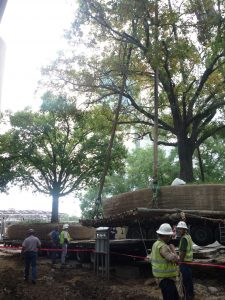
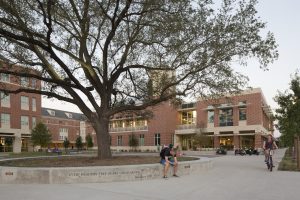
At Tulane University Weatherhead Hall was planned around the heritage trees – working with the architecture to define space and a signature identity.
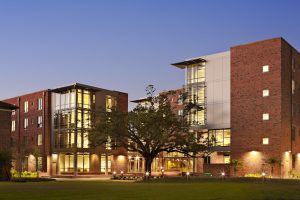
There are so many reasons to consider not only keeping the trees but also to just embrace the site ecology more broadly, whether this means reestablishing previous conditions or just intervening more gently on existing vegetation. When the children, like Imogene, ask, the planners and designers ought to have a better response than “they were, inconveniently, in the way.” Imogene knew that the site ecology—the trees, in her case—had value. It’s time that the owners, developers, and designers understand that value, too.
New Resources Available: Global Practice Primer
Three new chapters have been added to the AIA Global Practice Primer, covering human resources, technology in practice, and sustainability.
The AIA Global Practice Primer is designed for architects who are either considering the pursuit of projects abroad or are already engaged in international work. It serves to highlight the intricacies and differences when it comes to working abroad, including specifics on how international practice generally differs from domestic architectural practice in the US.
The primer was produced by the AIA International Practice Committee and features contributors with a wealth of first-hand knowledge and expertise on international projects. From business development and marketing to legal issues and project delivery, this primer is designed to provide architects with the basics needed to expand your work internationally.
The International Practice Committee Advisory Group invites commentary on this document’s content and usefulness. Submit any feedback to Theresa Palma, director of international relations, at theresapalma@aia.org.
Frickie Awarded Presidential Citation
On Friday, March 31, 2017 AIA Virginia President, Bill Brown, presented a Presidential Citation to Brian J. Frickie, AIA:
“Before you are a leader, success is all about grooming yourself. When you become a leader, leadership is all about grooming others.” ~ Jack Welch
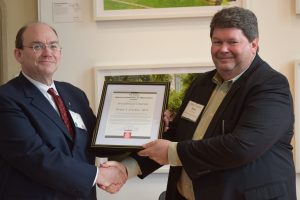
Brian J. Frickie, AIA is just such a leader, dedicating much of his career to “grooming others.” Many, many others. As the 2008 President of The Virginia Society AIA, Brian conceived of the Emerging Leaders in Architecture Program and has continually served as its primary shepherd.
Since its inception the following year, ‘the ELA’ has enhanced hundreds of lives, and these emergent leaders are visible statewide as principals of their firms, officers for their AIA components, and activists in their communities. The program transformed them … and they have, in turn, transformed us.
As he transitions away from his ELA role, his professional colleagues salute Brian J. Frickie, AIA for his devotion to grooming others, nurturing others, developing others, and inspiring others.
William T. Brown, AIA, President
Road Map For 2017
“We are more fulfilled when we are involved in something bigger than ourselves.” John Glenn
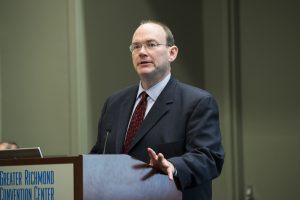
I am honored to have served as president-elect in 2016 as staff and the board collaboratively imagined what AIA Virginia could look like in 2020. I was taken by the collective energy in the room and the passion for our profession and our organization. I truly am humbled and honored to serve now as your 2017 President and my road map for 2017 is to guide the implementation of the Strategic Plan through my term.
My introduction to the AIA was through Edgar C. Beery Jr. FAIA in 1984 and I continue to find it to be such a wonderful community of people and resource for professional practice. Through this, I have come to ask myself the question of “How do I make a difference?” Whether it is making a difference in the community, at work or on a personal level the approach is not too different.
Recognize your beliefs and passions, be sincere, and be involved. Serve the community by first; educating yourself, second; contributing to the body of work and knowledge and consequently; volunteering your time to better our profession. I am committed to guiding the association’s continuing momentum to be member focused and reinvented as an effective and efficient organization. I pledge to “speak up” and advocate for our profession, and the communities we are part of, guided by the principles of the Virginia Accord. I truly believe that only through being personally engaged in the AIA can we accomplish great things as the AIA.
My passions are;
Advocating for the profession,
Leadership development and mentorship of those aspiring to rise, and
Enhancing the membership experience
There is much work to do to make our organization what we imagine it to be. There will be change, some easy and some difficult. I see myself as facilitator, advocate, and champion of the organization
In 2016 significant transformation in our organization was led by our President, Nick Vlattas, AIA and our Executive Vice President/CEO Helene Combs Dreiling, FAIA with support from an exceptional Board of Directors and a deeply committed and dedicated staff. There was significant collaboration with leadership from our five local components and with AIA National as the institute repositions itself for the fast-changing practice of architecture.
PRIORITIES
It is my hope to build upon the firm foundation of this last year with five goals:
- Elevate public awareness by positioning architects as vital contributors to our built environment.
- Advance the knowledge and expertise of members.
- Advocate for the profession.
- Implement a communication program that informs and facilitates connections.
- Become a model of a strong nonprofit and vibrant membership organization.
Highlights for next year include;
ART OF PRACTICE FORUM
The inaugural Art of Practice will be a one day conference presented by AIA Virginia designed to build skills required by the practice of our profession. Topics for discussion will include firm culture, marketing, new technology trends, and how to grow your practice. With relevant content for both small and large firms, no matter what stage in your career, we are sure there will be something for everyone. See you March 31, 2017, for this exciting conference!
VIRGINIA ACCORD
As we structure our programs and services in 2017, I also believe that we can build upon the principles of the VIRGINIA ACCORD. Shortly after the Centennial Celebration, under the leadership of then AIA Virginia President and Dean of the College of Architecture and Urban Studies at Virginia Tech, Jack Davis FAIA, the VIRGINIA ACCORD brought together planning, design, construction, and real estate disciplines to examine key themes critical to our future in the Commonwealth of Virginia. The VIRGINIA ACCORD recognized the excellent contributions of the past century and offered our promise for the future with five guiding principles:
- Commitment to contributing to job creation and a growing and thriving economy
- Commitment to constructing environmentally sustainable buildings
- Commitment to public health
- Commitment to systems of mass transit
- Commitment to responsible land development and urban infill
GOVERNMENT ADVOCACY
We will continue to work to create a healthy business environment for the architects in the Commonwealth. Raise the awareness of Citizen Architects and encourage members to be involved in their communities. We must create a more robust AIA VA PAC that is in line with other organizations to support those legislators that have a proven track record working with us in alignment with our priorities.
LEADERSHIP DEVELOPMENT
Continue the support and encouragement of emerging leaders. Strategically engage with ELA alumnae in order to encourage networking, engagement, and the future growth of the citizen architect program. The voice of emerging leaders must be heard.
SUMMARY
In summary, I am proud to be a part of this group of thought leaders and staff members that are diligently working collaboratively in your best interest to make these ideas actionable to the benefit of our members. It is with that frame of mind and with that spirit in my heart, working with my colleagues that I embark on the year ahead as a servant leader to the members of AIA Virginia.
Thank you.
Bill Brown, AIA
President 2017
AIA Virginia
Robert Ivy Reflects on 2015
AIA EVP/CEO Robert Ivy shares his appreciation for the great work in 2015 that resulted in significant progress for the AIA. Since these videos were recorded, the AIA total membership is now nearly 88,000 members.
AIA National Committees Seeking Nominees
AIA is seeking nominations for members to serve on AIA national committees.
This year, the process has been moved online. Login to your account (using the same login and password used for CES) and you will then see a screen listing all of the AIA national committees with openings in 2016. A click on the committee name will lead to a description of the committee’s charge.
Members will be required to submit a resume and a letter of interest for each committee application. The nomination process closes at 5:00 PM EST on Thursday, October 15; after that, the link will no longer be active. Appointments will be made by the end of 2015. Please note that applicants must be Architect or Associate members; the link will not work otherwise.
There are many other opportunities for national service not included here: awards, juries, etc. For those specific appointments, separate calls for nominations are sent at certain times of the year; we will make sure you are aware of those opportunities as they arise.
If you have any questions, please don’t hesitate to call or email Pam Day, Hon. AIA (202-626-7305, pday@aia.org
Look Up and Speak Up
The audience response to the “Look Up” campaign by the AIA has been overwhelmingly positive. Robert Ivy, FAIA, EVP/CEO of the American Institute of Architects asks AIA members to look up and speak up about issues concerning architecture. “We are out there in a way we haven’t been in years,” says Ivy. As awareness about what architects do increases we should view this as an opportunity to “Speak Up” for our profession and industry.

